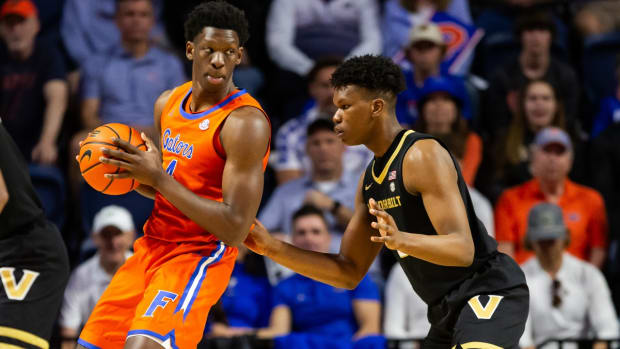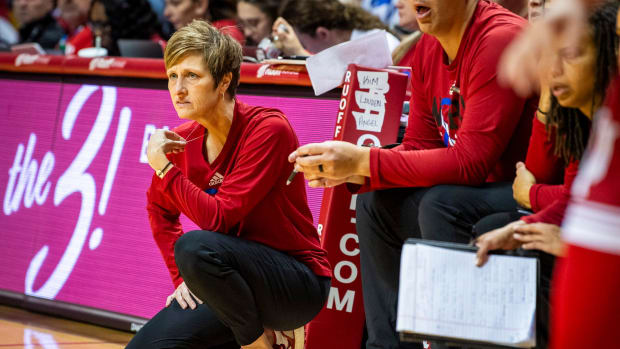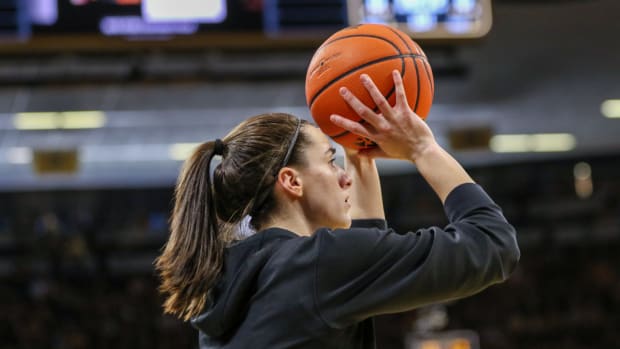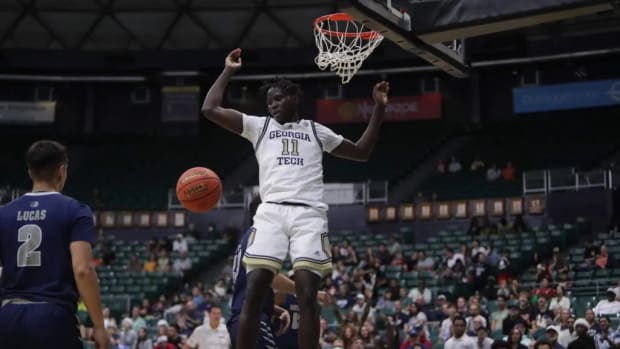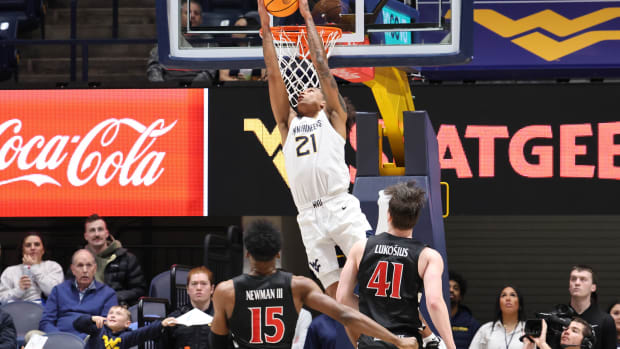March Madness is officially here, with all 68 teams officially locked into the 2022 men’s NCAA tournament bracket and games set to tip off Tuesday with the First Four. Inevitably, a team you’ve never watched this season will shock the sports world and introduce itself with a memorable upset or two in the Big Dance. Identifying that team beforehand, though, can be the hard part. Which Cinderella teams could blow up your bracket? We’ve been tracking top contenders all season and have ranked the 10 most likely clubs to do just that.
1. Colorado State (No. 6 seed, South Region)
After experiencing heartbreak on Selection Sunday a year ago, Colorado State left no doubt in 2021–22, putting together an incredibly impressive résumé and spending time in the top 25. The Rams feature one of the best players in the country in David Roddy, an incredibly unique forward with elite shooting touch despite a frame that looks more like that of a defensive lineman. But it’s not just Roddy that makes this team special—point guard Isaiah Stevens is one of the nation’s best floor generals and put up 17 points and 11 assists without a turnover in an early-season win over Creighton.
The Rams rank in the top 20 nationally in offensive efficiency per KenPom, but have proved in Mountain West wins over the likes of San Diego State and Boise State that they are capable of winning a grind-it-out style of game. To make a run to the Sweet 16 (or further), CSU will have to deal with some elite-level length and athleticism, especially up front. If there’s a weakness on this Rams team, it’s the center position, and it will have to deal with Michigan’s Hunter Dickinson in the first round and a potential date with Tennessee’s athletic roster in the second. But a team with two elite players like Roddy and Stevens will be a tough out, especially as well coached as this group is.
2. Loyola Chicago (No. 10 seed, South Region)
The Ramblers may have a new coach, but they’re back and capable of yet another run in the Big Dance. Drew Valentine is the youngest head coach in Division I but was part of both of Loyola’s recent runs and has his stamp on the program in his first year leading the Ramblers. Loyola plays faster than in years past and doesn’t rely on a post player like Cameron Krutwig, but it’s one of the nation’s most prolific three-point shooting teams and ranks in the top 25 nationally in defensive efficiency on KenPom.
Six of the seven key rotation players from last year’s Ramblers team that went to the Sweet 16 are still with this group. And this year, Loyola played tight games with Auburn and Michigan State and has beaten San Francisco, Vanderbilt, DePaul and Arizona State. It won’t be scared of the moment or intimidated by the size that first-round opponent Ohio State presents (especially with the Buckeyes’ recent struggles), and I guarantee No. 2 seed Villanova didn’t want to potentially draw a team this battle-tested in the second round.
3. San Diego State (No. 8 seed, Midwest Region)
It’s hard to believe that any high seed would want to see the Aztecs in this tournament with the way that they defend. SDSU ranks second nationally in defensive efficiency, per KenPom, trailing only Texas Tech in that statistic. The Aztecs are long, athletic and extremely well coached on that end of the floor, and they do a tremendous job of imposing their style of play on opposing teams.
The concern with SDSU has always been whether Brian Dutcher’s team would be able to score consistently enough to win against top competition. But the Aztecs have been better on that end of the floor lately, and the presence of elite isolation scorer Matt Bradley gives this group a guy who can create shots for himself when the offense bogs down. Bradley was quiet in the Mountain West tournament last week but has scored 24 or more points in a game seven times since Feb. 1.
The Aztecs’ defense should be a problem for first-round opponent Creighton, which is playing without freshman point guard Ryan Nembhard due to a season-ending wrist injury. And if the Aztecs can force their style of play on No. 1 seed Kansas? Watch out.
4. UAB (No. 12 seed, South Region)
Former Ole Miss coach Andy Kennedy has built something of a “Transfer U” at his alma mater to great success. The Blazers won 27 games in 2021–22, culminating in a C-USA tournament title, and did so while starting five transfers—all of whom are in their fourth, fifth or sixth year of college basketball. The headliner of that group is point guard Jordan “Jelly” Walker, who after stops at Seton Hall and Tulane has found a home in Kennedy’s guard-friendly system and has thrived. Walker averages more than 20 points per game and has made 115 threes this season at a 40.6% clip, so he’s a real weapon who can win you a game or two. Three other Blazers average double figures offensively, including versatile Ole Miss transfer forward KJ Buffen. This group’s experience level and athleticism means it won’t be overmatched by any high-major team physically, which is quite the luxury for a mid-major team.
Six of UAB’s seven losses this season have been by six points or fewer. That included heartbreaking losses to an at-large team in San Francisco and to high-major teams such as South Carolina and West Virginia. Plus, the Blazers enter the Big Dance having won seven straight games and playing their best basketball of the season at the right time. That’s bad news for first-round opponent Houston, a team that’s just 1–4 this season against top-50 KenPom teams and shouldn’t scare the Blazers from a talent standpoint without star guard Marcus Sasser.
5. San Francisco (No. 10 seed, East Region)
The Dons became the first WCC team not named Gonzaga, BYU or Saint Mary’s to earn an at-large bid in two decades, a remarkable feat for Todd Golden’s program. They’ve done it with tremendous guard play, savvy work in the transfer portal and an analytics-heavy approach that has allowed them to build this program to a top-25 finish in KenPom and the NET.
Point guard play is essential in March, and San Francisco has one of the best in the nation in Jamaree Bouyea, a fifth-year senior who is terrific at creating in ball screens and has impressive range from beyond the arc. He’s the straw that stirs the drink for the Dons, and when paired with dynamic two-way guard Khalil Shabazz creates a tough-to-stop duo. But what has truly unlocked the Dons’ improvement in 2021–22 has been the addition of Yauhen Massalski up front, as the transfer big man has become one of the best pick-and-roll finishers in the nation in addition to doing strong defensive work down low.
The Dons have faced Gonzaga three times and have been within 10 in the second half in all three games, so they certainly wouldn’t be overwhelmed by Kentucky’s size and athleticism in a potential round-of-32 game. Of course, that requires getting by fellow potential Cinderella Murray State.
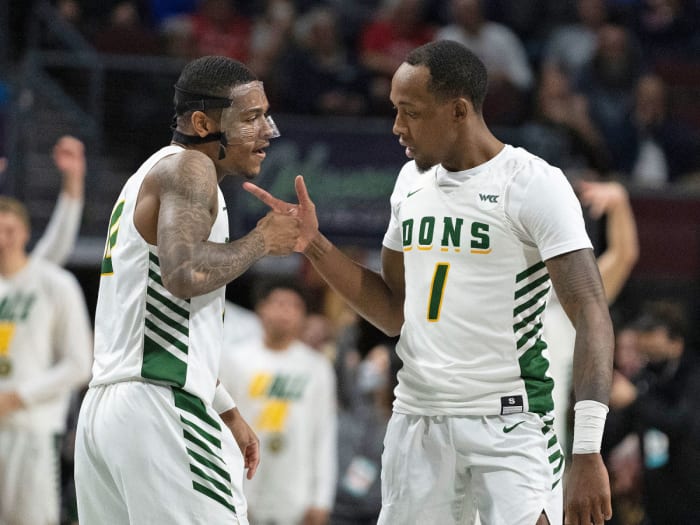
Can Bouyea (right) and the Dons get by fellow Cinderella candidate Murray State?
Kyle Terada/USA TODAY Sports
6. Murray State (No. 7 seed, East Region)
The Racers haven’t lost since Christmas and sport the best record in men’s college basketball. That’s a pretty compelling case alone for why Murray State can make a run in March Madness, but let’s dive into why the Racers have been so good in 2021–22. Offensively, Matt McMahon runs terrific sets that are difficult to prepare for and even harder to play against, running elite shooting wing Tevin Brown off an array of staggers and pindowns to get him open shots. Big man KJ Williams has scored 25 or more points seven times this season and is an impressive inside-out force, while guards Justice “Juice” Hill and Trae Hannibal bring high-major athleticism and attacking ability off the bounce. And on defense, the Racers do a tremendous job running teams off the three-point line and limiting opponents to one shot, a strong recipe for March success.
Despite playing in a relatively weak OVC, the Racers earned a No. 7 seed, which positions them better for success in the round of 64. Drawing San Francisco is a challenge, though. If they get past the Dons, can they topple an elite team in Kentucky in the second round and make the Sweet 16? That potential Bluegrass state rivalry game would be all kinds of fun, though Williams would certainly have his hands full dealing with Oscar Tshiebwe.
7. Indiana (No. 12 seed, East Region)
No, Indiana doesn’t exactly fit your traditional “Cinderella” label. But if there’s a team that can go from the First Four to a deep run like UCLA did last season, it’s the Hoosiers. IU is coming off an inspiring run at the Big Ten tournament that secured its place in the Big Dance, with wins over Michigan and Illinois before blowing a late lead against Iowa in the tournament semifinal.
So what has been the key for IU’s late-season surge? The play of point guard Xavier Johnson. Head coach Mike Woodson has been openly critical of his floor general at times this season, but Johnson has been sensational of late. In his last eight games, Johnson is averaging 18 points, four rebounds and nearly seven assists, and this is a different team when he’s aggressive attacking downhill to complement low-post presence Trayce Jackson-Davis.
Plus, the bracket plays out well for the Hoosiers. They draw a Wyoming team in the First Four that limped to the finish line to close out the regular season, then would face off with a Saint Mary’s team that isn’t overwhelming from a talent standpoint. And if the Hoosiers can get past a potential matchup with UCLA in the second round, No. 1 seed Baylor feels vulnerable due to injuries.
8. South Dakota State (No. 13 seed, Midwest Region)
The 30–4 Jackrabbits won’t have lost for more than three months by the time the ball is tipped in their first NCAA tournament game. This is a program that has been in this spotlight before, with close losses to the likes of Baylor, Maryland and Ohio State in the first round of the Big Dance in the last decade. But this year’s group has the best chance in program history of winning a March Madness game.
Why? South Dakota State is elite on the offensive end. The Jackrabbits rank in the top 15 in KenPom’s offensive efficiency metric, topping the nation in both three-point field goal percentage (a ridiculous 44.2% from deep) and effective field goal percentage (topping Gonzaga and Purdue at 59.7%). They take care of the ball, are loaded with shooters and have several weapons that can beat you. The biggest question is whether they can get enough stops—this isn’t an overly athletic team and it’s struggled to defend high-major competition this season, giving up 104 points to Alabama and 87 points to Washington. That might not be quite as big a concern against a Providence team that isn’t that explosive on the offensive end, and advanced metrics have suggested the Friars have overachieved for most of the season. Can the Jackrabbits end Providence’s incredible run in close games?
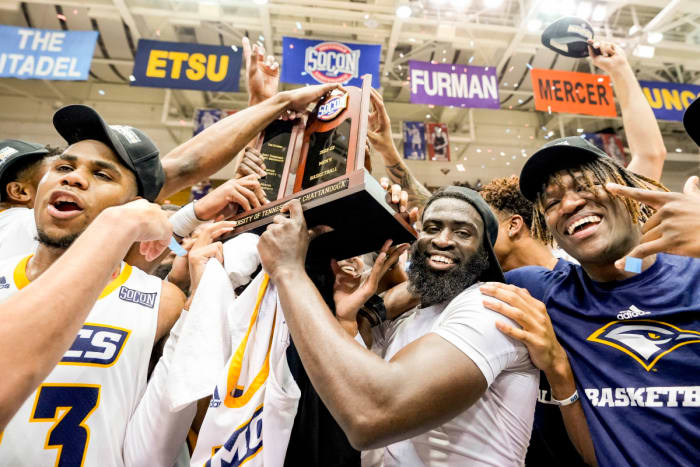
The Mocs earned their trip to the dance on a memorable buzzer beater by Jean-Baptiste.
Kathy Kmonicek/AP
9. Chattanooga (No. 13 seed, South Region)
If you’re looking for a mid-major that won’t be physically overwhelmed by high-major size and athleticism, the Mocs are your best bet. If you took the names off the front of their jerseys, you’d think Chattanooga was a high-major team. It has big, physical guards and athletic bigs who can guard on the perimeter. Star point guard Malachi Smith stands 6'4" and was recently ranked among SI’s top-50 players in the nation, averaging more than 20 points, six rebounds and three assists per game on ridiculous efficiency. Center Silvio De Sousa has revitalized his career with the Mocs after a tumultuous tenure at Kansas and is a defensive monster thanks to his ability to move his feet and switch onto guards. And then there’s early March hero David Jean-Baptiste, a gifted scoring guard who pairs well with the physical Smith in the backcourt.
This team isn’t a flashy one—it’ll look to control tempo in its first-round matchup against Illinois and rely on its defense in the half court. If he can stay out of foul trouble, De Sousa is about as strong a matchup with Illini big man Kofi Cockburn as possible for a mid-major team, given his elite recruiting pedigree and high-major experience. And with offensive and defensive efficiency marks both in the KenPom top 100, this is a balanced group that can win a game or two.
10. Davidson (No. 10 seed, West Region)
This might be the best Davidson team Bob McKillop has had since Stephen Curry was introducing the country to the small private school in North Carolina. This team doesn’t have a future NBA star like Curry, but it does share his penchant for drilling threes in bunches. The Wildcats rank in the top 10 nationally in three-point percentage, knocking down more than 38% of their perimeter attempts on the season. It was shooting that lifted the Wildcats to a nonconference win over Alabama, drilling 12 of 24 threes against the Tide in a matchup that will be somewhat comparable talent-wise to the Wildcats’ first-round date with Michigan State.
The main knock on Davidson would be a lack of overall athleticism (especially compared to teams such as MSU and potential second-round matchup Duke), but the Wildcats do have excellent positional size. Big men Luka Brajkovic and Sam Mennenga stand 6’10” and 6’9", respectively, and starting wing Hyunjung Lee stands 6'7". All three are capable of hitting outside shots, with Lee and Brajkovic among the best shooters in the country at their respective positions. When Lee, Brajkovic, Foster Loyer and Michael Jones are on the floor, Davidson has four shooters who are capable of taking over a game from beyond the arc. Plus, Davidson’s offense is incredibly hard to prepare for because of how it cuts and shares the basketball.
More March Madness Coverage:
• Men’s Bracket Breakdown: A Region-by-Region Guide
• SI’s Experts Make Their Bracket Picks
• Five Tips for Filling Out Your Bracket












